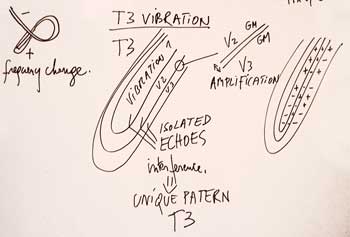|
|
|
Some remarks (1)
1. Since the whole Tunity process is very dynamic, dimensional conditions can shift or change very fast (in Universe time of course). Changes in other tubes will influence membrane tension, temperature changes and surface properties.
2. The impact position of a pelastration in a tube may vary. A tube can be hit in the middle (straight through the inner channel) or in an outside zone (creating an unbalanced skin). Each pelastration brings in a tube-zone a shock-wave and after the pelastration of the second wand a vacuuming effect.
3. Each pelastrated dimension after the T1 level has at least one double spacetime curl (two membranes skinning the pelastrating tube ... warping the penetrated membranes).
4. Each dimension that is coiled (spiral strangled) by an surrounding tube has local spacetime shifts (particles appear and disappear)(e.g. winding mode of motion and winding number).
5. A tube-zone can appear as a flattered dimension depending from the forces which formed it.
6. A pelestrating tube or one of his splitting sub-tubes may become positioned between two existing dimensions (e.g. T6 positions in T2 between the outer layer T1 and T2.)
7. Tubes can influence each other by outer contact (e.g. spaghetti and other pasta's).
8. Tubes can exchange 'echoes' (through skin membrane layer contact) even throughout the whole constellation (Tunity). The subsequential portals may filter but will also redistribute to the impacted tube. A shift in one of the layers of a tube will create similar patterns in the other layers .
|
 |
|
|
|
|
|
|
|
|
|
|
|
|